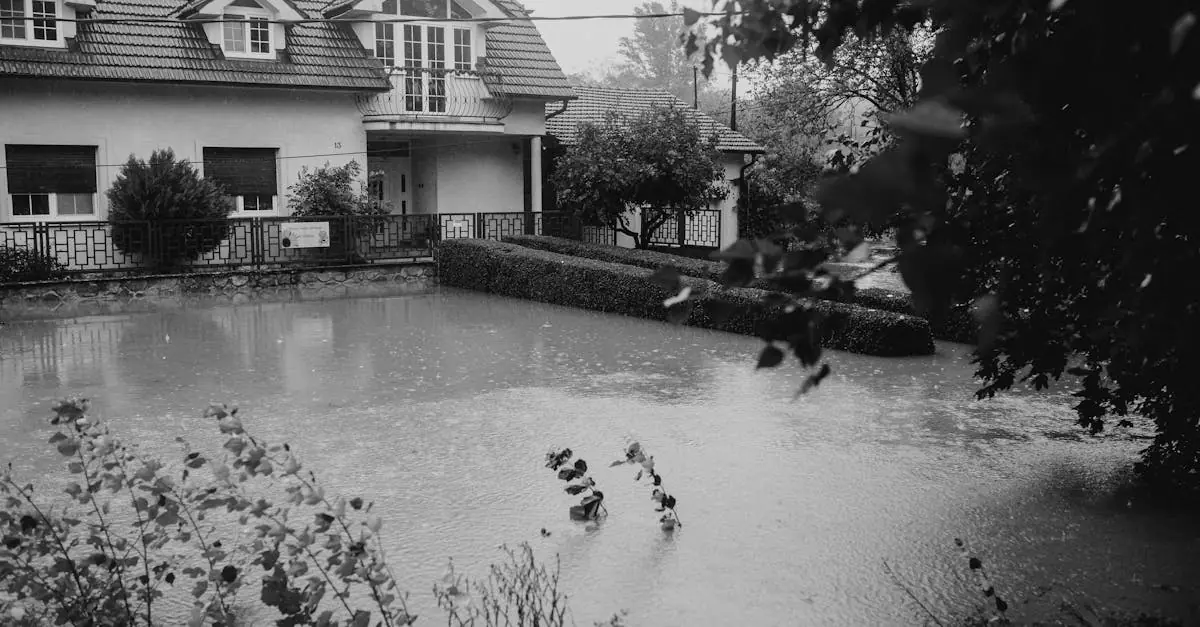Table of Contents
ToggleWhen the ground starts shaking, it’s not just a dance party for tectonic plates. Homeowners often wonder if their insurance policy will step in to save the day—or if they’re left to fend for themselves like a cat in a dog park. Earthquakes can strike without warning, leaving a trail of chaos and confusion.
So, does homeowners insurance cover earthquake damage? Spoiler alert: it’s not as straightforward as a “yes” or “no.” Many policies come with a few surprises that could leave homeowners feeling like they’re on shaky ground. Navigating the ins and outs of coverage can feel like trying to find a needle in a haystack, but understanding the details can make all the difference when the earth decides to do a little jig.
Understanding Homeowners Insurance
Homeowners insurance offers crucial financial protection for property owners. Many homeowners recognize its importance, yet the specifics of coverage can vary significantly.
What Is Homeowners Insurance?
Homeowners insurance is a policy designed to safeguard homes and their contents. It covers damages caused by a range of perils, including fire, theft, and weather-related incidents. Beyond property protection, it also provides liability coverage. Such coverage protects homeowners against claims for bodily injury or property damage that occur on their premises. Each policy differs in its terms and limits, making it essential for homeowners to understand their specific coverage.
Types of Coverage Included
Several types of coverage come standard with homeowners insurance policies. Dwelling coverage protects the structure of the home from damages caused by covered perils. Personal property coverage includes belongings inside the home, like furniture and electronics. Liability coverage tackles legal expenses if someone gets injured on the property. Additional living expenses coverage pays for the costs incurred when homeowners can’t reside in their home due to covered damages. Understanding these aspects helps homeowners ensure adequate protection against unexpected events.
Earthquake Damage and Homeowners Insurance
Homeowners often face confusion regarding earthquake damage coverage. Many assume their standard insurance policies include such protection, but this is frequently not the case.
Common Misconceptions
It’s a common belief that all homeowners insurance policies cover earthquake damage. However, those policies typically exclude seismic events. Misunderstandings about coverage lead homeowners to feel unprepared when earthquakes occur. For instance, some policies offer comprehensive disaster coverage, yet they might not extend this protection to earthquakes specifically. Educating oneself about the specific threats in one’s location is crucial for adequate preparation. Each homeowner should verify their policy details to understand the actual coverage.
The Fine Print: Exclusions
Insurance policies contain specific exclusions that homeowners must recognize. Earthquake damage often appears as a notable exclusion in most standard homeowners insurance documents. Those documents highlight other types of damage that may receive coverage, but seismic events often remain absent. Some homeowners might discover earthquake coverage as an optional endorsement; however, this varies by insurer and location. Reading through the fine print is essential to avoid financial surprises. Knowing the exclusions helps homeowners make informed decisions regarding additional earthquake insurance options.
Types of Earthquake Insurance
Homeowners can choose from various types of earthquake insurance to protect their properties from seismic events. Understanding these options helps them make informed decisions regarding their coverage.
Standalone Earthquake Insurance
Standalone earthquake insurance is a policy specifically dedicated to covering damages caused by earthquakes. This type of insurance provides comprehensive coverage for structural damage, personal property loss, and additional living expenses resulting from an earthquake. Many insurers offer these policies in high-risk areas, ensuring homeowners can obtain necessary protection. Coverage limits and premiums vary based on location, property value, and other risk factors. Homeowners must evaluate these factors to select the best standalone policy for their needs.
Endorsements to Homeowners Policies
Endorsements to homeowners policies provide an alternative way to obtain earthquake coverage. Insurers may allow homeowners to add an earthquake endorsement to their standard policies for an additional premium. This endorsement typically covers structural damage and personal property losses caused by earthquakes but may come with specific limits and exclusions. Homeowners should carefully review their options and the details of any endorsement to understand its coverage clearly. Evaluating the costs and benefits of adding this endorsement aids homeowners in making suitable insurance decisions.
Factors Influencing Coverage
Several factors determine the coverage homeowners receive for earthquake damage. Understanding these factors assists homeowners in making informed decisions regarding their insurance.
Location and Risk Assessment
Seismic activity plays a crucial role in assessing earthquake coverage. High-risk areas such as California often see insurers require additional earthquake policies. Insurers evaluate local geology, history of seismic events, and proximity to fault lines when determining risk assessment. Homeowners in lower-risk zones like parts of the Midwest might find more lenient coverage options. Ratings from organizations like the United States Geological Survey (USGS) provide valuable insight into local earthquake hazards. Homeowners should review their location’s risk level and discuss it with their insurance agent to understand coverage needs better.
Home Value and Structure Types
The type of home and its value significantly impact earthquake insurance coverage. Homes with a higher market value generally incur higher coverage costs. Insurers examine structural materials, age of the building, and foundation type when setting premiums. For example, brick homes typically face higher risks than wooden structures, influencing policy options. A homeowner’s choice of renovations or upgrades can also affect coverage availability. Newer constructions, especially those adhering to earthquake-resistant standards, may attract lower premiums. Evaluating the home’s specifics enables homeowners to secure appropriate insurance protection against earthquake damages.
Understanding homeowners insurance coverage for earthquake damage is essential for every property owner. Many policies exclude this critical protection leaving homeowners vulnerable during seismic events. By educating themselves on their specific policy details and recognizing potential exclusions, homeowners can make informed decisions about additional coverage options.
Whether considering standalone earthquake insurance or endorsements to existing policies, it’s vital to evaluate personal risk factors and property specifics. With the right knowledge and preparation, homeowners can ensure they’re adequately protected against the unpredictable nature of earthquakes. Taking these steps not only safeguards their investment but also provides peace of mind in the face of uncertainty.





